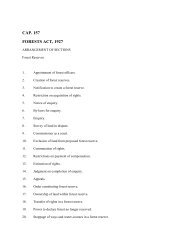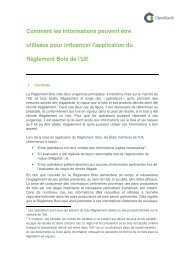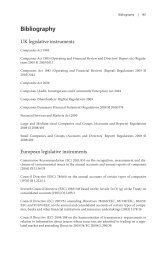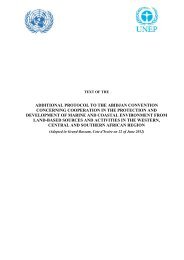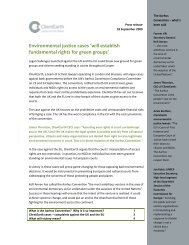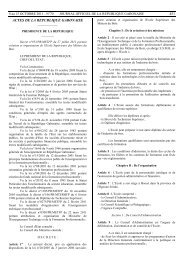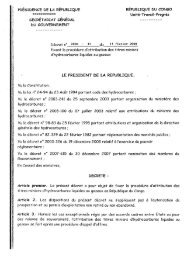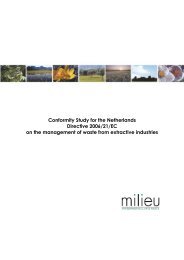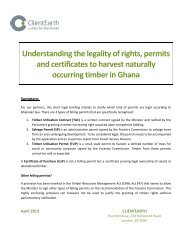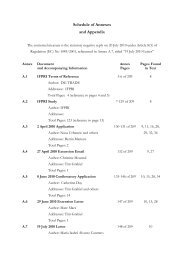Environmental and social transparency under the ... - ClientEarth
Environmental and social transparency under the ... - ClientEarth
Environmental and social transparency under the ... - ClientEarth
- No tags were found...
Create successful ePaper yourself
Turn your PDF publications into a flip-book with our unique Google optimized e-Paper software.
164 | <strong>Environmental</strong> <strong>and</strong> <strong>social</strong> <strong>transparency</strong> <strong>under</strong> <strong>the</strong> Companies Act 2006Notes | 16566Accounting St<strong>and</strong>ards Board, ‘Reporting St<strong>and</strong>ard (RS) 1 The Operating <strong>and</strong> FinancialReview’ (May 2005).67Companies exist as legal ‘persons’. The fundamental idea is that a company has a separatelegal existence to its shareholders. Thus a shareholding company has a separate legal personalityto <strong>the</strong> company in which it holds shares.68s 1162 Companies Act 2006 defines a company as a parent company if it fulfils one of <strong>the</strong>following criteria: it holds a majority of <strong>the</strong> voting rights in <strong>the</strong> company; it is a member of<strong>the</strong> company <strong>and</strong> has <strong>the</strong> right to appoint or remove a majority of its board of directors; ithas <strong>the</strong> right to exercise a dominant influence over <strong>the</strong> company (i) by virtue of provisionscontained in <strong>the</strong> <strong>under</strong>taking’s articles of association, or (ii) by virtue of a control contract;it is a member of <strong>the</strong> company <strong>and</strong> controls alone, pursuant to an agreement with o<strong>the</strong>rshareholders or members, a majority of <strong>the</strong> voting rights in <strong>the</strong> <strong>under</strong>taking.69The doctrinal position is that as all shareholders have ‘limited liability’ in relation to acompany, thus parent companies (as shareholders of <strong>the</strong> subsidiary) are subject to limitedliability in relation to <strong>the</strong> subsidiary’s activities. This ‘limited liability’ of shareholdersapplies to shareholding by companies (parents in subsidiaries); <strong>the</strong>refore in most cases parentcompanies are not liable for <strong>the</strong> debts <strong>and</strong> responsibilities of its subsidiaries in law.Exceptions to <strong>the</strong> rule are as yet few <strong>and</strong> far between.70s 399 Companies Act 2006. Companies that are publicly listed in <strong>the</strong> European Communityare required to prepare <strong>the</strong>ir Group Accounts in accordance with InternationalAccounting St<strong>and</strong>ards (IAS), <strong>under</strong> s 403 Companies Act 2006 <strong>and</strong> Article 4 of <strong>the</strong> ‘IASRegulation’ (Council Regulation (EC) 1606/2002 of 19 July 2002 on <strong>the</strong> application of internationalaccounting st<strong>and</strong>ards [2002] OJ L243/1). See Annex 1 for fur<strong>the</strong>r detail.71s 415(2) Companies Act 2006.72The exemptions are, broadly, if (a) <strong>the</strong>y are subsidiaries of a larger group who have preparedgroup reports (to a certain st<strong>and</strong>ard) which include that company, <strong>and</strong> a numberof procedural conditions are satisfied ; (b) all subsidiaries may be excluded <strong>under</strong> s 405Companies Act 2006 , by virtue of (i) <strong>the</strong> subsidiaries’ inclusion being immaterial to givinga ‘true <strong>and</strong> fair’ view of <strong>the</strong> company , (ii) severe long-term restrictions on <strong>the</strong> parent’sexercise of control over <strong>the</strong> subsidiary , (iii) disproportionate expense or delay , or (iv) <strong>the</strong>interest held in <strong>the</strong> subsidiary being held exclusively with a view to resale . Unless one of<strong>the</strong>se exemptions applies, parent companies must produce annual accounts for <strong>the</strong>ir companygroup as a whole. See Annex 1 for fur<strong>the</strong>r detail.73Large <strong>and</strong> Medium-sized Companies <strong>and</strong> Groups (Accounts <strong>and</strong> Reports) Regulations2008 Schedule 4 also provide certain specific accounting requirements relating to ‘significant’shareholdings, <strong>and</strong> o<strong>the</strong>r contractual relationships.74s 417(5)(c) Companies Act 2006.75Linklaters, ‘The Companies Act 2006: A Guide to <strong>the</strong> Reforms: Part 2: Narrative reporting,liability <strong>and</strong> auditors’ (December 2006), p. 5.76Hansard HL vol 686 col 453 (2 November 2006).77s 417(11) Companies Act 2006.78Linklaters, ‘The Companies Act 2006: A Guide to <strong>the</strong> Reforms: Part 2: Narrative reporting,liability <strong>and</strong> auditors’, p. 5.79s 423(1) Companies Act 2006.80As required to be included in <strong>the</strong> directors’ report by paragraph 14 of <strong>the</strong> Large <strong>and</strong>Medium-sized Companies <strong>and</strong> Groups (Accounts <strong>and</strong> Reports) Regulations 2008: “anynecessary explanatory material” with regard to specific aspects of <strong>the</strong> requirements of s416 Companies Act 2006. Broadly, <strong>the</strong>se relate to <strong>the</strong> company’s capital structure; securitiestransfer restrictions; details of significant direct or indirect holdings; details of specialrights of control; rights of control of any employees’ share schemes; restrictions on votingrights; restrictions on <strong>the</strong> transfer of securities or on voting rights; rules that <strong>the</strong> companyhas about appointment <strong>and</strong> replacement of directors, or amendment of <strong>the</strong> company’sarticles of association; powers of <strong>the</strong> company’s directors; information relating to takeoverbids.81Regulation 5(2) Companies (Summary Financial Statement) Regulations 2008 SI2008/374.82Regulation 5(1) Companies (Summary Financial Statement) Regulations 2008.83s 430(1)(b) Companies Act 2006.84ss 475, 495, 496, 497 Companies Act 2006.85s 495(1) Companies Act 2006.86s 499(1)(a) Companies Act 2006.87s 499(1)(b) Companies Act 2006.88s 499(2) Companies Act 2006. Such persons are: any officer or employee of <strong>the</strong> company;any person holding or accountable for any of <strong>the</strong> company’s books, accounts or vouchers;any subsidiary <strong>under</strong>taking of <strong>the</strong> company incorporated in <strong>the</strong> UK; any officer, employeeor auditor of any such subsidiary <strong>under</strong>taking or any person holding or accountable forany books, accounts or vouchers of any such subsidiary <strong>under</strong>taking; any person who fellwithin any of <strong>the</strong> above at a time to which <strong>the</strong> information or explanations required by <strong>the</strong>auditor relates or relate. Auditors also have <strong>the</strong> right to oblige parent companies to takeall steps that are ‘reasonably open to it’ to secure any information or explanations that arenecessary for <strong>the</strong> purposes of <strong>the</strong> audit from a subsidiary (or employee of that subsidiary)not subject to UK law (Section 500 Companies Act 2006).89s 495(2)(b) Companies Act 2006.90s 495(4)(a) Companies Act 2006.91s 495(3)(c) Companies Act 2006. Also, where applicable, in accordance with Article 4 of<strong>the</strong> IAS Regulation.



